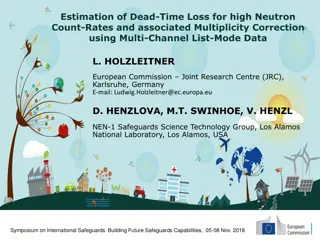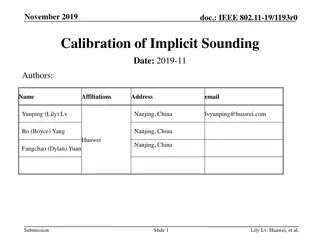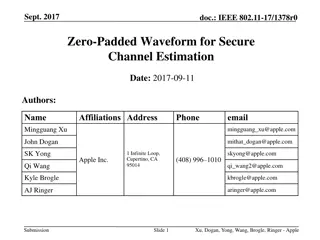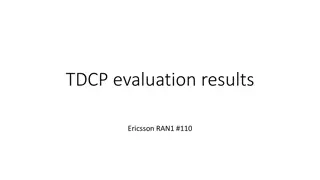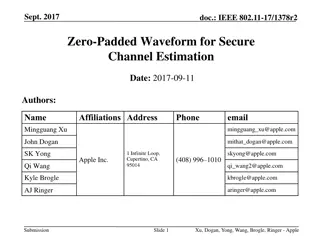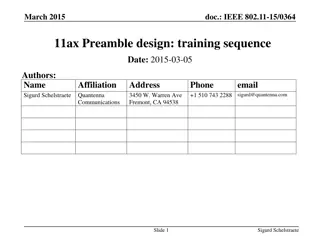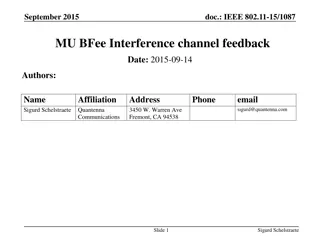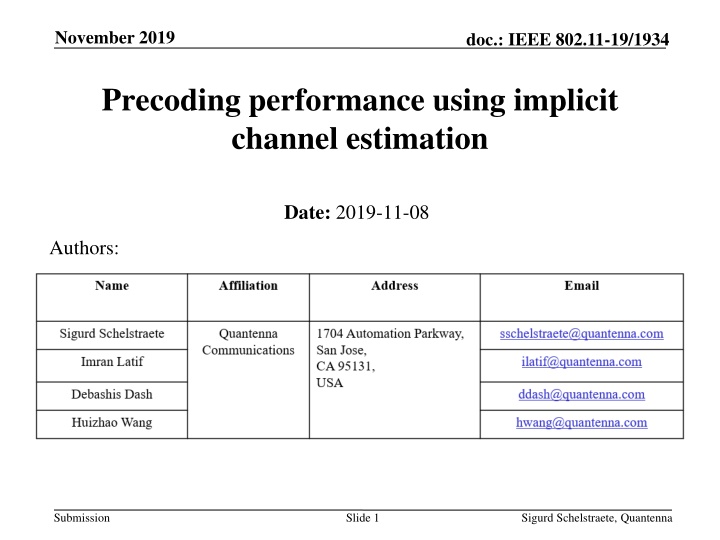
Implicit Channel Estimation for IEEE 802.11: Performance Analysis
Explore the performance of implicit channel estimation in IEEE 802.11 networks for reducing sounding overhead. The study compares implicit and explicit sounding protocols, evaluates precoding performance, and discusses the use of implicit channel estimates. Experimental setups, calibration methods, and simulation results are examined to understand the implications on channel estimation accuracy and wireless communication efficiency.
Download Presentation

Please find below an Image/Link to download the presentation.
The content on the website is provided AS IS for your information and personal use only. It may not be sold, licensed, or shared on other websites without obtaining consent from the author. If you encounter any issues during the download, it is possible that the publisher has removed the file from their server.
You are allowed to download the files provided on this website for personal or commercial use, subject to the condition that they are used lawfully. All files are the property of their respective owners.
The content on the website is provided AS IS for your information and personal use only. It may not be sold, licensed, or shared on other websites without obtaining consent from the author.
E N D
Presentation Transcript
November 2019 doc.: IEEE 802.11-19/1934 Precoding performance using implicit channel estimation Date: 2019-11-08 Authors: Submission Slide 1 Sigurd Schelstraete, Quantenna
November 2019 doc.: IEEE 802.11-19/1934 Introduction Current 802.11 sounding protocols are based on sounding followed by explicit sounding feedback These explicit protocols can potentially take up a lot of airtime Implicit sounding [1, 2] has been suggested as a way to reduce sounding overhead Overhead of different schemes (implicit vs. explicit) was compared in [4] Submission Slide 2 Sigurd Schelstraete, Quantenna
November 2019 doc.: IEEE 802.11-19/1934 Introduction An important question is how well implicit channel estimation (CE) performs when used with precoding This submission looks at precoding performance using either implicit or explicit channel estimates We use a combination of measured and simulation results Submission Slide 3 Sigurd Schelstraete, Quantenna
November 2019 doc.: IEEE 802.11-19/1934 Implicit channel estimation Channel estimate obtained for reverse channel Beamformer may request BFee to send NDP Or wait for an ad-hoc opportunity BFer estimates reverse channel from the NDP (or other packet) BFer adjusts reverse channel with calibration coefficients and uses it as an approximation of the forward channel Submission Slide 4 Sigurd Schelstraete, Quantenna
November 2019 doc.: IEEE 802.11-19/1934 Experimental & simulation setup Channel measurements were taken in different environments Shield Box Office environment BFer: 4x4 AP BFee: 2x2 STA H matrix collected using NDP on both ends 2x4 AP STA channels 4x2 STA AP channels Submission Slide 5 Sigurd Schelstraete, Quantenna
November 2019 doc.: IEEE 802.11-19/1934 Experimental & simulation setup (2) Calibration was performed off-line on the measured (reverse) channels (MATLAB) Calibration coefficients were determined using MMSE criterion Precoding based on explicit DL channel was compared with precoding based on calibrated UL channel Using the measured channels in simulation Both BF and MU Submission Slide 6 Sigurd Schelstraete, Quantenna
November 2019 doc.: IEEE 802.11-19/1934 Setup ???,???= ???,??? ???,??= ???,?? ?1 0 0 ?(???)= ???? ?? ?. ?? ???? ??( , ) ? ?= ??? ???( , ) ???? ??( , ). ???? ??( , ) Submission Slide 7 Sigurd Schelstraete, Quantenna
November 2019 doc.: IEEE 802.11-19/1934 Results for BF Three different scenarios are considered Performance without BF Performance with BF using explicit channel information Performance with BF using calibrated implicit channel information Channel measurements were taken in shielded environment and in office environment As recorded by the Wi-Fi devices Measured and calibrated channels were used in MATLAB simulation to find performance Submission Slide 8 Sigurd Schelstraete, Quantenna
November 2019 doc.: IEEE 802.11-19/1934 SU BF performance - shieldbox MCS 7, 2 SS Setup in shielded environment Virtually no difference between Implicit CE with and explicit CE Submission Slide 9 Sigurd Schelstraete, Quantenna
November 2019 doc.: IEEE 802.11-19/1934 SU BF performance over the air MCS 7, 2 SS Measurements taken in office environment Minor degradation from implicit feedback Submission Slide 10 Sigurd Schelstraete, Quantenna
November 2019 doc.: IEEE 802.11-19/1934 Calibration coefficients phase amplitude Submission Slide 11 Sigurd Schelstraete, Quantenna
November 2019 doc.: IEEE 802.11-19/1934 Results for MU Three different scenarios considered MU with 4-stream feedback MU with 8-stream feedback MU with implicit (calibrated) channel feedback AP is 8x8, STA is 2x2 Channels are simulated channel D with added impairments to model front-end Amplitude offset Random phase offsets Submission Slide 12 Sigurd Schelstraete, Quantenna
November 2019 doc.: IEEE 802.11-19/1934 MU performance Simulated Channel D with various amplitude offsets Random phase offsets Major improvement relative to 4SS feedback 1 1.5 dB difference relative to 8SS feedback Submission Slide 13 Sigurd Schelstraete, Quantenna
November 2019 doc.: IEEE 802.11-19/1934 Summary Presented results for precoding based on implicit channel estimation Simple calibration algorithm used More advanced algorithms could be considered SU performance Little to no degradation MU performance Major improvement over 4-stream feedback Minor degradation relative to 8-stream feedback NOTE: impact of overhead not considered in assessing performance Submission Slide 14 Sigurd Schelstraete, Quantenna
November 2019 doc.: IEEE 802.11-19/1934 Conclusion Implicit channel estimation with calibration is a good candidate method for reducing sounding overhead Submission Slide 15 Sigurd Schelstraete, Quantenna
November 2019 doc.: IEEE 802.11-19/1934 References [1] MU sounding improvements, IEEE 802.11-18/1191 [2] Implicit Channel Sounding in IEEE 802.11, IEEE 802.11-19/0768 [3] Implicit Channel Sounding in IEEE 802.11 (Feasibility Study), IEEE 802.11-19/0767 [4] Implicit sounding overhead analysis, IEEE 802.11- 19/1268 Submission Slide 16 Sigurd Schelstraete, Quantenna




